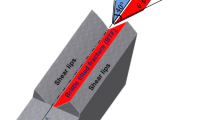Abstract
The ordinary Weibull distribution function has been commonly accepted for empirical characterization of cleavage fracture toughness of nuclear reactor and containment pressure vessel steels. However, this method lacks a fundamental basis. This work adopts the standardized Weibull distribution function to analyze cleavage fracture toughness of ferritic steels measured from different sized fracture mechanics specimens at different temperatures to estimate the Weibull modulus. The toughness data of five different nuclear reactor and containment vessel steels are analyzed. The estimations obtained the Weibull modulus (m) in the range of 1.83 to 2.55 and strong temperature dependence of the threshold cleavage fracture toughness Kmin, as opposed to the constant values of mK = 4 and Kmin = 20 MPam1/2 given in ASTM E1921-19. The goodness of fit test by the one-sample Kolmogorov–Smirnov (K–S) test validated Weibull distribution function for describing the toughness distribution.



















Similar content being viewed by others
References
ASTM E 1921-19: Standard test method for determination of reference temperature, T0, for ferritic steels in the transition range, ASTM International, 2019.
W.-S. Lei: Mech. Mater. 2016, vol. 101, pp. 81-92.
G. Qian W.-S. Lei, Z. Tong, and Z. Yu: Materials, 2019, vol. 12, paper # 982. https://doi.org/10.3390/ma12060982
J.D. Landes and D.H. Shaffer: Statistical characterization of fracture in the transition region. In: fracture mechanics: twelfth conference. ASTM STP 700, Philadephia: American Society for Testing and Materials, 1980, pp. 368–82.
J.D. Landes and D.E. McCabe: Effect of section size on trnsition temperature behavior of structural steels, In: R.J. Sanford (Ed.), Fracture Mechanics: 15th Symposium, ASTM STP 833, Philadephia: American Society for Testing and Materials,1984, pp.378-392.
D.E. McCabe: A Comparison of Weibull and βIc analyses of transition range data. Presented at the 23rd National Symposium on Fracture Mechanics, College Station, TX, 18-20, June, 1991. http://www.iaea.org/inis/collection/NCLCollectionStore/_Public/23/021/23021397.pdf
B. Margolin, A. Gulenko and V. Shvetsova: Fracture toughness prediction for RPV steels with various degree of embrittlement. Transactions of the 17th International Conference on Structural Mechanics in Reactor Technology (SMiRT 17) Prague, Czech Republic, August 17 –22, 2003, Paper # G03-4. 7 pages.
F.M. Beremin: Metall. Trans. A, 1983, vol. 14, pp. 2277-2287.
K. Wallin: Eng. Fract. Mech. 1984, vol. 19, pp. 1085-1093.
W.-S. Lei: Mech. Mater. 2016, vol. 93, pp. 184-198.
W.-S. Lei: Philos. Mag. 2016, vol. 96, pp. 3586-3631.
D.C. Montgomery and G.C. Runger, Applied Statistics and Probability for Engineers, 3rd edition. Wiley, Hoboken; 2003.
Y.L. Zhang, H. Hui, J.B. Zhang, Z.Q. Zhou, X. Hu, and X. Cong: Int. J. Pres. Ves. Pip. 2020, 182, pp. 1040331–10403310.
P.T. Williams, T.L. Dickson, and S. Yin: Fracture Analysis of Vessels — Oak Ridge FAVOR v04.1, Computer Code: Theory and Implementation of Algorithms, Methods, and Correlations (NUREG/CR-6854, ORNL/TM-2004/244). https://www.nrc.gov/reading-rm/doc-collections/nuregs/contract/cr6854/
K. Onizawa, T. Tobita, and M. Suzuki: Investigation on the evaluation of cleavage fracture toughness using PCCv specimens in the ductile-brittle transition range of reactor pressure vessel steels (Contract Research), Report of Japan Atomic Energy Research Institute #JAERI-Research-97-081, 1997. http://www.iaea.org/inis/collection/NCLCollectionStore/_Public/29/019/29019931.pdf
J. Heerens and D. Hellmann: Eng. Fract. Mech., 2002, vol. 69, pp. 421-449.
H.C. Kaner, S.G. Mohanty, and J.C. Lyons: Psychological Bulletin, 88(2), 498–501 (1980)
E. Lucon and M. Scibetta: Application of Advanced Master Curve Approaches to the EURO Fracture Toughness Data Set. In: S. Kalluri, M. McGaw, and A. Neimitz (Eds.), STP1526-EB Fatigue and Fracture Mechanics: 37th Volume, Philadephia: ASTM International, 2011, pp. 116-129. doi: https://doi.org/10.1520/STP49283S.
T. Meshii: Theor. Appl. Fract. Mech., 2019, vol. 100, pp. 354-361.
M.T. Kirk, The technical basis for application of the Master Curve to the assessment of nuclear reactor pressure vessel integrity, United States Nuclear Regulatory Commission, The Agencywide Documents Access and Management System (ADAMS), ML093540004, 2002. https://www.nrc.gov/docs/ML0935/ML093540004.pdf
Acknowledgments
GQ is grateful to the funding of National Natural Science Foundation of China (Grant Nos. 11872364, 11932020) and Chinese Academy of Science (CAS) Pioneer Hundred Talents Program.
Author information
Authors and Affiliations
Corresponding authors
Additional information
Publisher's Note
Springer Nature remains neutral with regard to jurisdictional claims in published maps and institutional affiliations.
Manuscript submitted October 4, 2020, accepted January 28, 2021.
Rights and permissions
About this article
Cite this article
Lei, WS., Qian, G., Yu, Z. et al. Weibull Modulus of Cleavage Fracture Toughness of Ferritic Steels. Metall Mater Trans A 52, 1503–1515 (2021). https://doi.org/10.1007/s11661-021-06169-w
Received:
Accepted:
Published:
Issue Date:
DOI: https://doi.org/10.1007/s11661-021-06169-w




